BFC5935 Portfolio Management: Financial Assets Risk Assessment Report
VerifiedAdded on 2022/09/26
|6
|1398
|35
Report
AI Summary
This report analyzes the risk associated with financial assets, specifically focusing on CBA, QAN, and ANZ stocks. It explores portfolio diversification, comparing and contrasting the returns and risks of portfolios based on CBA and QAN, and CBA and ANZ. The analysis includes calculating the coefficient of variation to assess stock volatility, determining the efficiency of different portfolios, and examining the levels of coefficients and p-values of the Intercept and Beta. The report also evaluates the consistency of the regression results with the Capital Asset Pricing Model (CAPM) predictions, providing insights into the relationship between risk and return for the selected stocks. The findings highlight the importance of diversification, risk assessment, and the application of financial models in making informed investment decisions, with considerations for both risk-averse and risk-taking investors. The report concludes with a discussion on the implications of beta values and CAPM in assessing the value and risk of CBA stock.
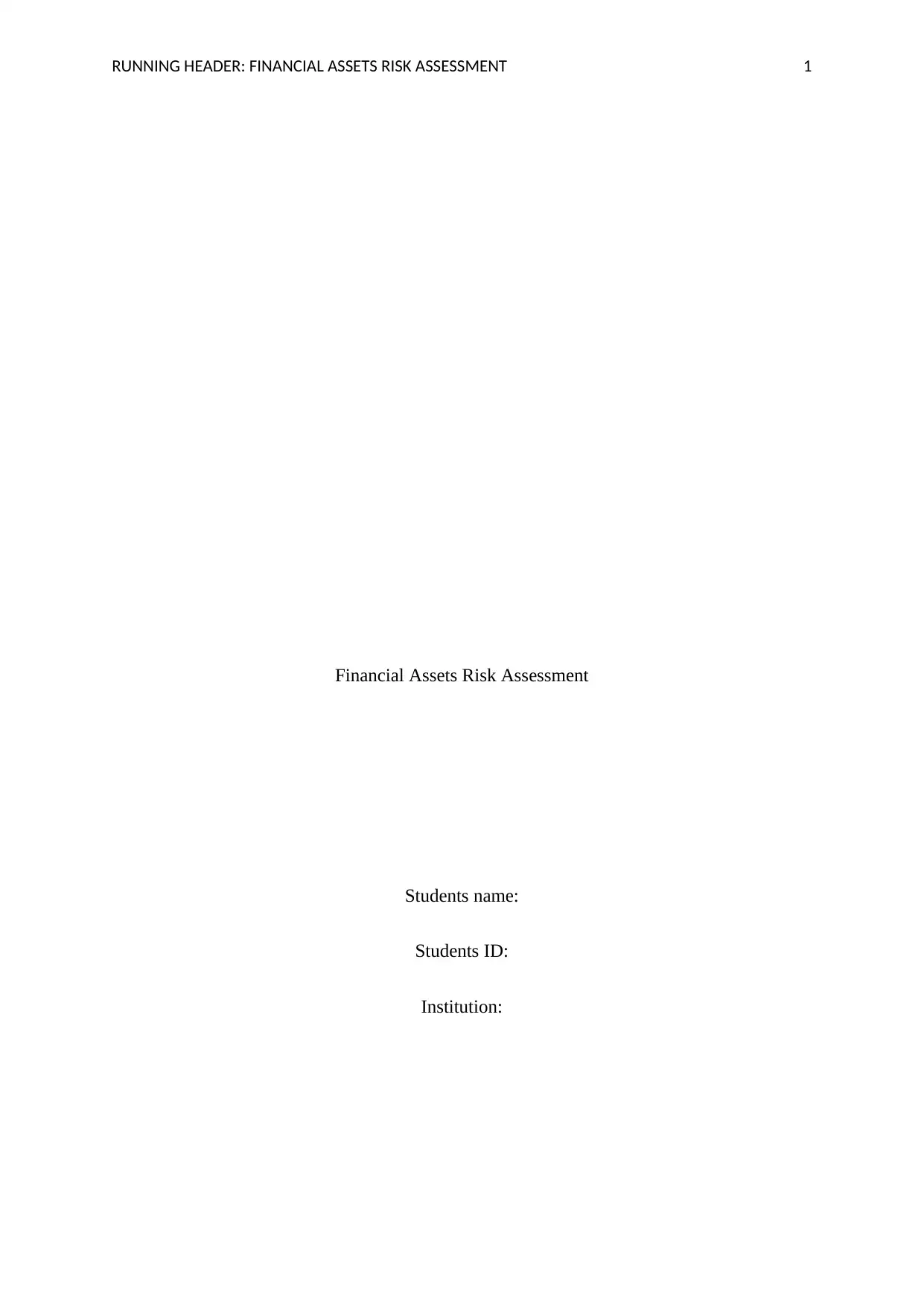
RUNNING HEADER: FINANCIAL ASSETS RISK ASSESSMENT 1
Financial Assets Risk Assessment
Students name:
Students ID:
Institution:
Financial Assets Risk Assessment
Students name:
Students ID:
Institution:
Paraphrase This Document
Need a fresh take? Get an instant paraphrase of this document with our AI Paraphraser
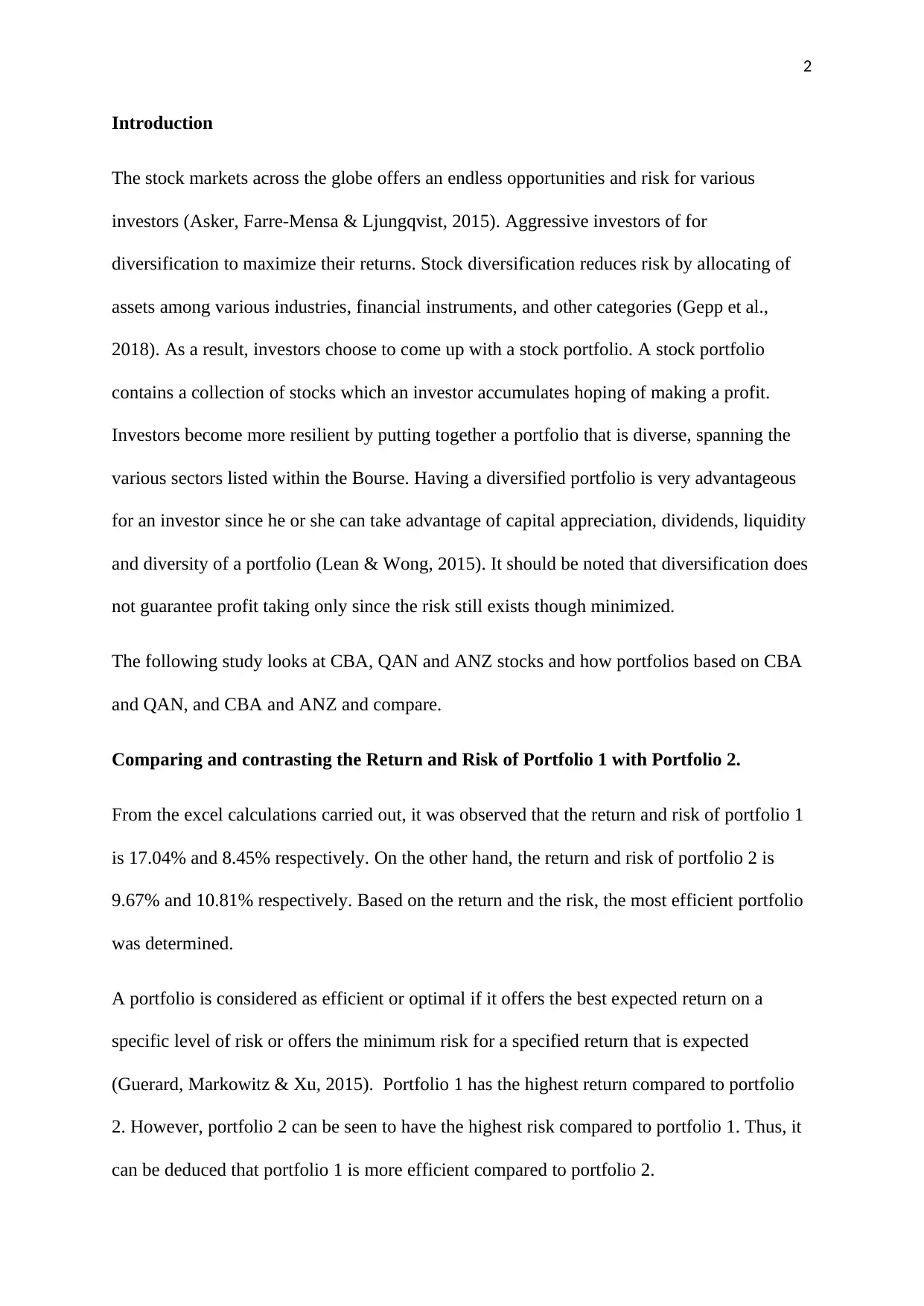
2
Introduction
The stock markets across the globe offers an endless opportunities and risk for various
investors (Asker, Farre-Mensa & Ljungqvist, 2015). Aggressive investors of for
diversification to maximize their returns. Stock diversification reduces risk by allocating of
assets among various industries, financial instruments, and other categories (Gepp et al.,
2018). As a result, investors choose to come up with a stock portfolio. A stock portfolio
contains a collection of stocks which an investor accumulates hoping of making a profit.
Investors become more resilient by putting together a portfolio that is diverse, spanning the
various sectors listed within the Bourse. Having a diversified portfolio is very advantageous
for an investor since he or she can take advantage of capital appreciation, dividends, liquidity
and diversity of a portfolio (Lean & Wong, 2015). It should be noted that diversification does
not guarantee profit taking only since the risk still exists though minimized.
The following study looks at CBA, QAN and ANZ stocks and how portfolios based on CBA
and QAN, and CBA and ANZ and compare.
Comparing and contrasting the Return and Risk of Portfolio 1 with Portfolio 2.
From the excel calculations carried out, it was observed that the return and risk of portfolio 1
is 17.04% and 8.45% respectively. On the other hand, the return and risk of portfolio 2 is
9.67% and 10.81% respectively. Based on the return and the risk, the most efficient portfolio
was determined.
A portfolio is considered as efficient or optimal if it offers the best expected return on a
specific level of risk or offers the minimum risk for a specified return that is expected
(Guerard, Markowitz & Xu, 2015). Portfolio 1 has the highest return compared to portfolio
2. However, portfolio 2 can be seen to have the highest risk compared to portfolio 1. Thus, it
can be deduced that portfolio 1 is more efficient compared to portfolio 2.
Introduction
The stock markets across the globe offers an endless opportunities and risk for various
investors (Asker, Farre-Mensa & Ljungqvist, 2015). Aggressive investors of for
diversification to maximize their returns. Stock diversification reduces risk by allocating of
assets among various industries, financial instruments, and other categories (Gepp et al.,
2018). As a result, investors choose to come up with a stock portfolio. A stock portfolio
contains a collection of stocks which an investor accumulates hoping of making a profit.
Investors become more resilient by putting together a portfolio that is diverse, spanning the
various sectors listed within the Bourse. Having a diversified portfolio is very advantageous
for an investor since he or she can take advantage of capital appreciation, dividends, liquidity
and diversity of a portfolio (Lean & Wong, 2015). It should be noted that diversification does
not guarantee profit taking only since the risk still exists though minimized.
The following study looks at CBA, QAN and ANZ stocks and how portfolios based on CBA
and QAN, and CBA and ANZ and compare.
Comparing and contrasting the Return and Risk of Portfolio 1 with Portfolio 2.
From the excel calculations carried out, it was observed that the return and risk of portfolio 1
is 17.04% and 8.45% respectively. On the other hand, the return and risk of portfolio 2 is
9.67% and 10.81% respectively. Based on the return and the risk, the most efficient portfolio
was determined.
A portfolio is considered as efficient or optimal if it offers the best expected return on a
specific level of risk or offers the minimum risk for a specified return that is expected
(Guerard, Markowitz & Xu, 2015). Portfolio 1 has the highest return compared to portfolio
2. However, portfolio 2 can be seen to have the highest risk compared to portfolio 1. Thus, it
can be deduced that portfolio 1 is more efficient compared to portfolio 2.
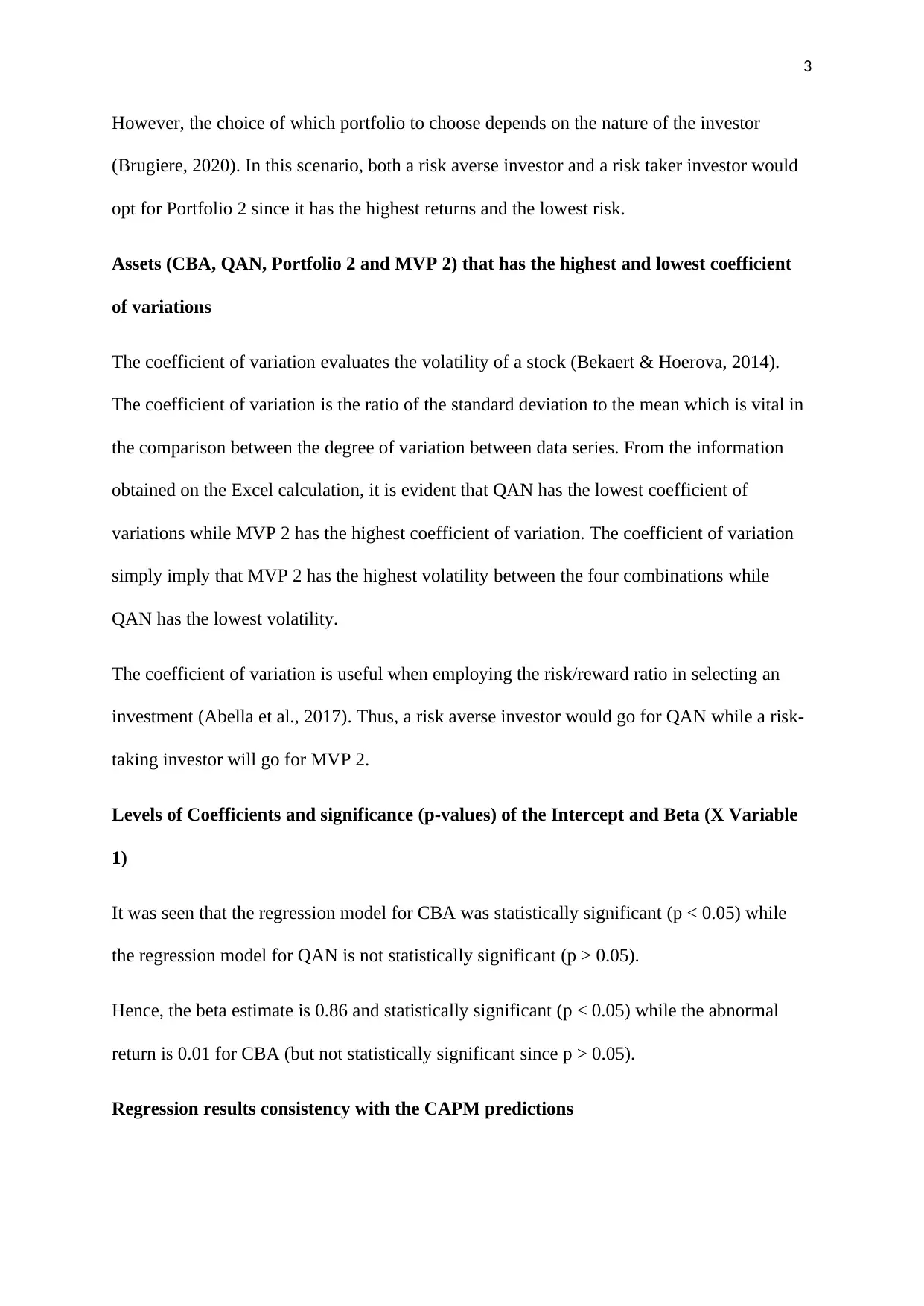
3
However, the choice of which portfolio to choose depends on the nature of the investor
(Brugiere, 2020). In this scenario, both a risk averse investor and a risk taker investor would
opt for Portfolio 2 since it has the highest returns and the lowest risk.
Assets (CBA, QAN, Portfolio 2 and MVP 2) that has the highest and lowest coefficient
of variations
The coefficient of variation evaluates the volatility of a stock (Bekaert & Hoerova, 2014).
The coefficient of variation is the ratio of the standard deviation to the mean which is vital in
the comparison between the degree of variation between data series. From the information
obtained on the Excel calculation, it is evident that QAN has the lowest coefficient of
variations while MVP 2 has the highest coefficient of variation. The coefficient of variation
simply imply that MVP 2 has the highest volatility between the four combinations while
QAN has the lowest volatility.
The coefficient of variation is useful when employing the risk/reward ratio in selecting an
investment (Abella et al., 2017). Thus, a risk averse investor would go for QAN while a risk-
taking investor will go for MVP 2.
Levels of Coefficients and significance (p-values) of the Intercept and Beta (X Variable
1)
It was seen that the regression model for CBA was statistically significant (p < 0.05) while
the regression model for QAN is not statistically significant (p > 0.05).
Hence, the beta estimate is 0.86 and statistically significant (p < 0.05) while the abnormal
return is 0.01 for CBA (but not statistically significant since p > 0.05).
Regression results consistency with the CAPM predictions
However, the choice of which portfolio to choose depends on the nature of the investor
(Brugiere, 2020). In this scenario, both a risk averse investor and a risk taker investor would
opt for Portfolio 2 since it has the highest returns and the lowest risk.
Assets (CBA, QAN, Portfolio 2 and MVP 2) that has the highest and lowest coefficient
of variations
The coefficient of variation evaluates the volatility of a stock (Bekaert & Hoerova, 2014).
The coefficient of variation is the ratio of the standard deviation to the mean which is vital in
the comparison between the degree of variation between data series. From the information
obtained on the Excel calculation, it is evident that QAN has the lowest coefficient of
variations while MVP 2 has the highest coefficient of variation. The coefficient of variation
simply imply that MVP 2 has the highest volatility between the four combinations while
QAN has the lowest volatility.
The coefficient of variation is useful when employing the risk/reward ratio in selecting an
investment (Abella et al., 2017). Thus, a risk averse investor would go for QAN while a risk-
taking investor will go for MVP 2.
Levels of Coefficients and significance (p-values) of the Intercept and Beta (X Variable
1)
It was seen that the regression model for CBA was statistically significant (p < 0.05) while
the regression model for QAN is not statistically significant (p > 0.05).
Hence, the beta estimate is 0.86 and statistically significant (p < 0.05) while the abnormal
return is 0.01 for CBA (but not statistically significant since p > 0.05).
Regression results consistency with the CAPM predictions
⊘ This is a preview!⊘
Do you want full access?
Subscribe today to unlock all pages.

Trusted by 1+ million students worldwide
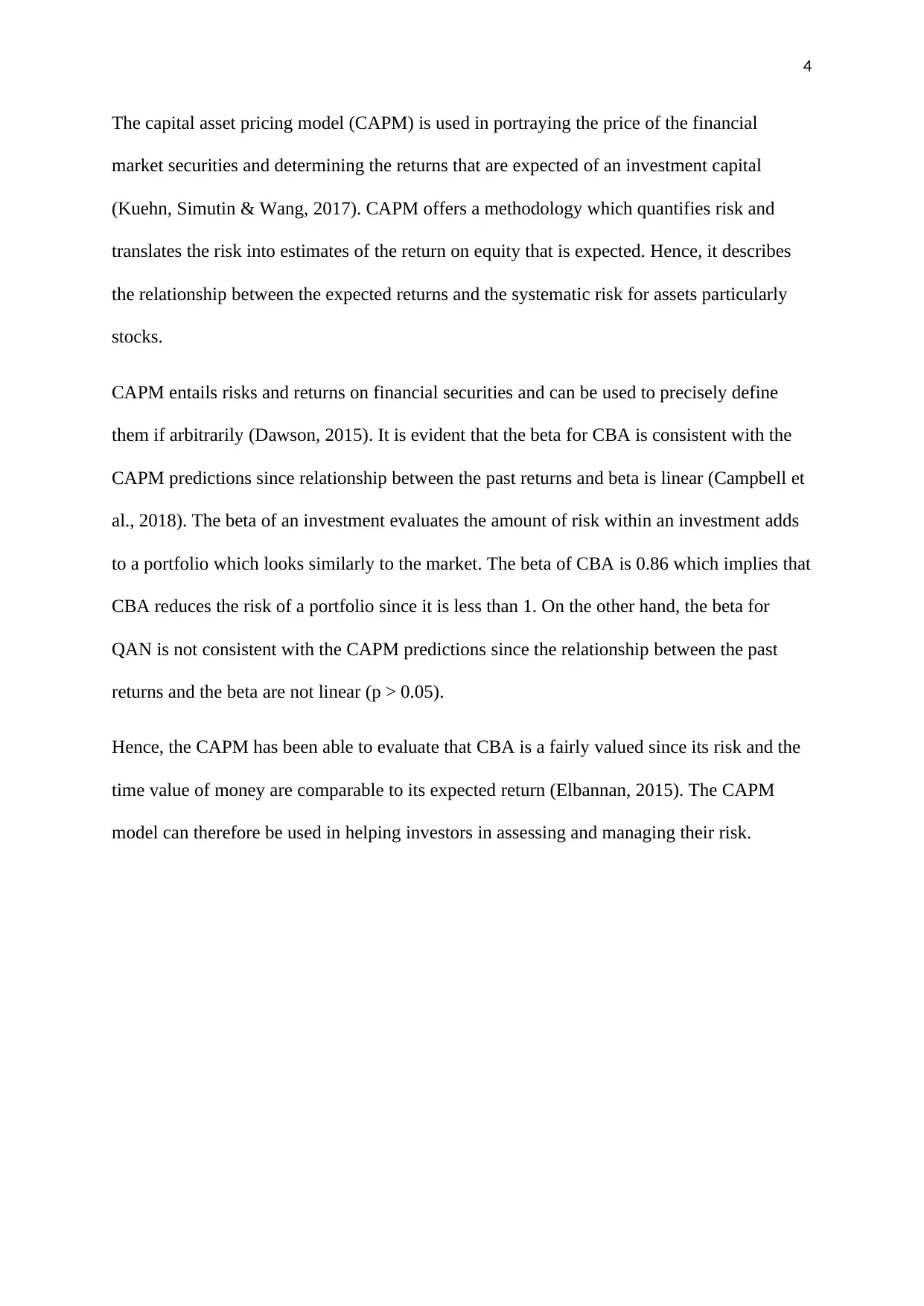
4
The capital asset pricing model (CAPM) is used in portraying the price of the financial
market securities and determining the returns that are expected of an investment capital
(Kuehn, Simutin & Wang, 2017). CAPM offers a methodology which quantifies risk and
translates the risk into estimates of the return on equity that is expected. Hence, it describes
the relationship between the expected returns and the systematic risk for assets particularly
stocks.
CAPM entails risks and returns on financial securities and can be used to precisely define
them if arbitrarily (Dawson, 2015). It is evident that the beta for CBA is consistent with the
CAPM predictions since relationship between the past returns and beta is linear (Campbell et
al., 2018). The beta of an investment evaluates the amount of risk within an investment adds
to a portfolio which looks similarly to the market. The beta of CBA is 0.86 which implies that
CBA reduces the risk of a portfolio since it is less than 1. On the other hand, the beta for
QAN is not consistent with the CAPM predictions since the relationship between the past
returns and the beta are not linear (p > 0.05).
Hence, the CAPM has been able to evaluate that CBA is a fairly valued since its risk and the
time value of money are comparable to its expected return (Elbannan, 2015). The CAPM
model can therefore be used in helping investors in assessing and managing their risk.
The capital asset pricing model (CAPM) is used in portraying the price of the financial
market securities and determining the returns that are expected of an investment capital
(Kuehn, Simutin & Wang, 2017). CAPM offers a methodology which quantifies risk and
translates the risk into estimates of the return on equity that is expected. Hence, it describes
the relationship between the expected returns and the systematic risk for assets particularly
stocks.
CAPM entails risks and returns on financial securities and can be used to precisely define
them if arbitrarily (Dawson, 2015). It is evident that the beta for CBA is consistent with the
CAPM predictions since relationship between the past returns and beta is linear (Campbell et
al., 2018). The beta of an investment evaluates the amount of risk within an investment adds
to a portfolio which looks similarly to the market. The beta of CBA is 0.86 which implies that
CBA reduces the risk of a portfolio since it is less than 1. On the other hand, the beta for
QAN is not consistent with the CAPM predictions since the relationship between the past
returns and the beta are not linear (p > 0.05).
Hence, the CAPM has been able to evaluate that CBA is a fairly valued since its risk and the
time value of money are comparable to its expected return (Elbannan, 2015). The CAPM
model can therefore be used in helping investors in assessing and managing their risk.
Paraphrase This Document
Need a fresh take? Get an instant paraphrase of this document with our AI Paraphraser
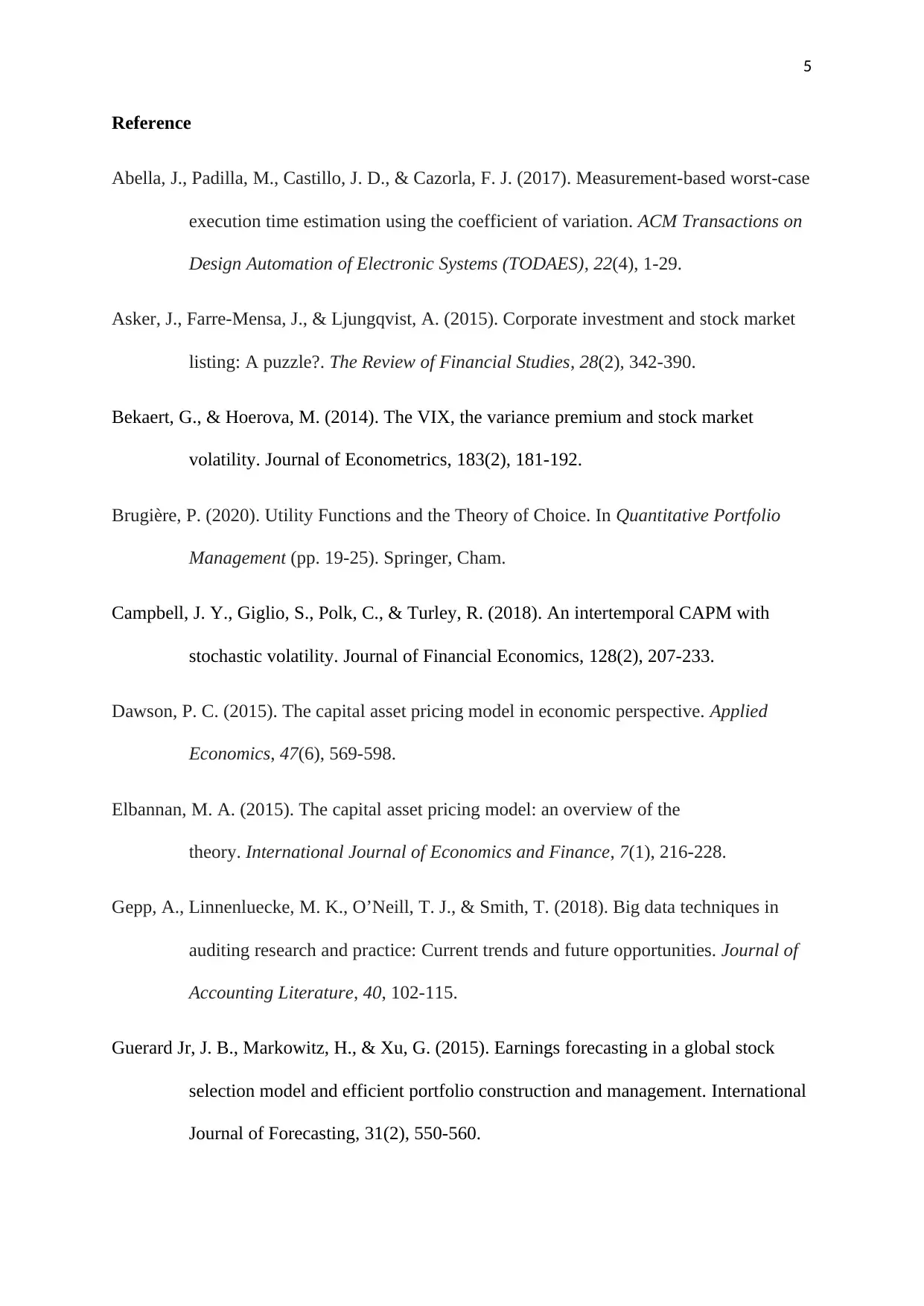
5
Reference
Abella, J., Padilla, M., Castillo, J. D., & Cazorla, F. J. (2017). Measurement-based worst-case
execution time estimation using the coefficient of variation. ACM Transactions on
Design Automation of Electronic Systems (TODAES), 22(4), 1-29.
Asker, J., Farre-Mensa, J., & Ljungqvist, A. (2015). Corporate investment and stock market
listing: A puzzle?. The Review of Financial Studies, 28(2), 342-390.
Bekaert, G., & Hoerova, M. (2014). The VIX, the variance premium and stock market
volatility. Journal of Econometrics, 183(2), 181-192.
Brugière, P. (2020). Utility Functions and the Theory of Choice. In Quantitative Portfolio
Management (pp. 19-25). Springer, Cham.
Campbell, J. Y., Giglio, S., Polk, C., & Turley, R. (2018). An intertemporal CAPM with
stochastic volatility. Journal of Financial Economics, 128(2), 207-233.
Dawson, P. C. (2015). The capital asset pricing model in economic perspective. Applied
Economics, 47(6), 569-598.
Elbannan, M. A. (2015). The capital asset pricing model: an overview of the
theory. International Journal of Economics and Finance, 7(1), 216-228.
Gepp, A., Linnenluecke, M. K., O’Neill, T. J., & Smith, T. (2018). Big data techniques in
auditing research and practice: Current trends and future opportunities. Journal of
Accounting Literature, 40, 102-115.
Guerard Jr, J. B., Markowitz, H., & Xu, G. (2015). Earnings forecasting in a global stock
selection model and efficient portfolio construction and management. International
Journal of Forecasting, 31(2), 550-560.
Reference
Abella, J., Padilla, M., Castillo, J. D., & Cazorla, F. J. (2017). Measurement-based worst-case
execution time estimation using the coefficient of variation. ACM Transactions on
Design Automation of Electronic Systems (TODAES), 22(4), 1-29.
Asker, J., Farre-Mensa, J., & Ljungqvist, A. (2015). Corporate investment and stock market
listing: A puzzle?. The Review of Financial Studies, 28(2), 342-390.
Bekaert, G., & Hoerova, M. (2014). The VIX, the variance premium and stock market
volatility. Journal of Econometrics, 183(2), 181-192.
Brugière, P. (2020). Utility Functions and the Theory of Choice. In Quantitative Portfolio
Management (pp. 19-25). Springer, Cham.
Campbell, J. Y., Giglio, S., Polk, C., & Turley, R. (2018). An intertemporal CAPM with
stochastic volatility. Journal of Financial Economics, 128(2), 207-233.
Dawson, P. C. (2015). The capital asset pricing model in economic perspective. Applied
Economics, 47(6), 569-598.
Elbannan, M. A. (2015). The capital asset pricing model: an overview of the
theory. International Journal of Economics and Finance, 7(1), 216-228.
Gepp, A., Linnenluecke, M. K., O’Neill, T. J., & Smith, T. (2018). Big data techniques in
auditing research and practice: Current trends and future opportunities. Journal of
Accounting Literature, 40, 102-115.
Guerard Jr, J. B., Markowitz, H., & Xu, G. (2015). Earnings forecasting in a global stock
selection model and efficient portfolio construction and management. International
Journal of Forecasting, 31(2), 550-560.

6
Kuehn, L. A., Simutin, M., & Wang, J. J. (2017). A labor capital asset pricing model. The
Journal of Finance, 72(5), 2131-2178.
Lean, H. H., & Wong, W. K. (2015). Is gold good for portfolio diversification? A stochastic
dominance analysis of the Paris stock exchange. International Review of Financial
Analysis, 42, 98-108.
Kuehn, L. A., Simutin, M., & Wang, J. J. (2017). A labor capital asset pricing model. The
Journal of Finance, 72(5), 2131-2178.
Lean, H. H., & Wong, W. K. (2015). Is gold good for portfolio diversification? A stochastic
dominance analysis of the Paris stock exchange. International Review of Financial
Analysis, 42, 98-108.
⊘ This is a preview!⊘
Do you want full access?
Subscribe today to unlock all pages.

Trusted by 1+ million students worldwide
1 out of 6
Related Documents
Your All-in-One AI-Powered Toolkit for Academic Success.
+13062052269
info@desklib.com
Available 24*7 on WhatsApp / Email
![[object Object]](/_next/static/media/star-bottom.7253800d.svg)
Unlock your academic potential
Copyright © 2020–2025 A2Z Services. All Rights Reserved. Developed and managed by ZUCOL.




